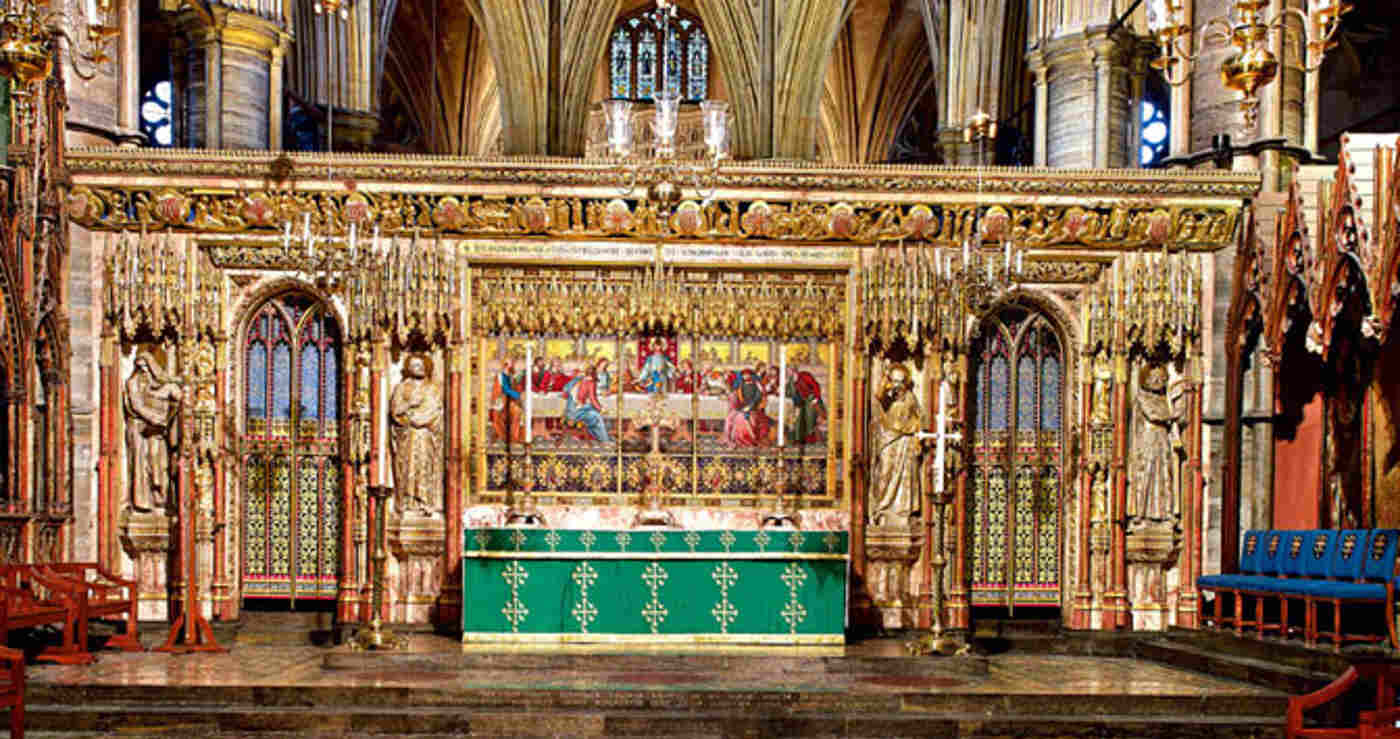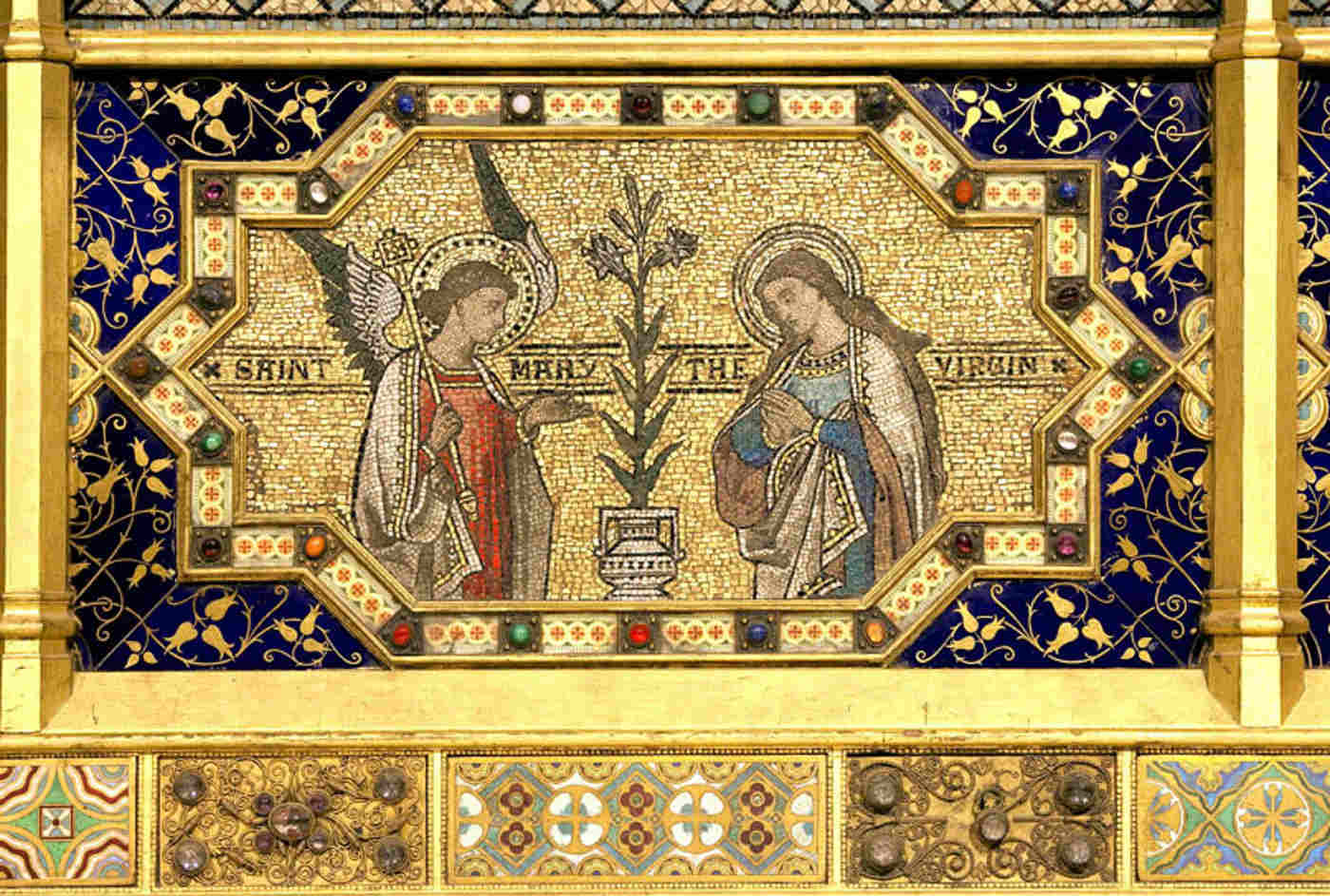Explore our History
High Altar
The Sacrarium, or Sanctuary, is at the heart of the Abbey, where the High Altar stands.
Altar decoration and detail
The altar is dedicated to St Peter. It was originally consecrated on 13th October 1269. The present wooden altar table, normally covered by an embroidered frontal, and reredos above it were designed by the Abbey Surveyor Sir George Gilbert Scott in 1866-67. The mosaic of the Last Supper was designed by J.R. Clayton and executed by Antonio Salviati. The inscription along the top reads "The kingdoms of this world are become the kingdoms of our Lord and of his Christ" (from the book of Revelation).
A gilded frieze above shows scenes from the life of Christ. There are four large statues of Moses, St Peter, St Paul and King David, by H.H. Armstead, flanking the altar. The doors on either side lead into St Edward the Confessor's chapel which is immediately behind the screen. On the altar table are two candlesticks, bought with money bequeathed by a serving maid called Sarah Hughes, who worked for one of the clergymen in the 17th century. The silver gilt cross was given in 1899 by Lord Rosebery, following his daughter's marriage here.

High Altar
Around the altar
In front of the High Altar is one of the Abbey's treasures. This is a marble pavement dating from 1268 and the method of its decoration is known as Cosmati work, after the Italian family who developed the technique of inlaying intricate designs made up of small pieces of coloured marble, into a plain marble ground. Materials used include onyx, porphyry, serpentine and coloured glass. It is 24 feet 10 inches square and one of the three Latin inscriptions incorporated in it calculated that the world would last for 19,683 years.
To the south of the High Altar are two figures of kings, thought to represent Henry III and Edward I, painted on the Sedilia (or seats for the priests). This was erected in the reign of Edward I under Abbot Wenlok. The two other religious figures have been defaced. Also on this side is the low marble tomb of Anne of Cleves, 4th wife of Henry VIII.
On the north side are three medieval tombs to Edmund Crouchback, brother of Edward I, Aymer de Valence and Edmund's wife Aveline.
Also in this area is the Abbey lectern, or reading desk, given in 1949 in memory of the Baptist missionary William Carey. The 17th century oak pulpit stands near the steps up to the Sacrarium.

High Altar mosaic detail - the Annunciation
History of the altar
At a coronation ceremony, the ancient Coronation Chair stands facing the High Altar and the anointing and crowning take place here. Various royal weddings have taken place at the altar, including that of Prince William in 2011.
The ancient Retable, now on display in the Queen's Diamond Jubilee Galleries at the Abbey, is thought to have formed part of the medieval altar. A depiction of the altar appears in the 1532 mortuary roll of Abbot Islip, also on display in the Galleries.
An oil painting in the Galleries shows the altar as it was in about 1700, covered with hangings, but in 1706 Queen Anne presented a large altarpiece that had originally been made for James II and placed in his chapel at Whitehall Palace. It was designed by Christopher Wren, with sculptures by Arnold Quellin. A few fragments from this still survive. This was taken down in 1821 and a plaster altar table designed by Francis Bernasconi took its place until Scott designed the present altar and reredos.
Relax in front of the High Altar
Experience the high altar and quire of the Abbey during an early summer morning - from the comfort of your home. Watch the full video and relax, pray or meditation.



